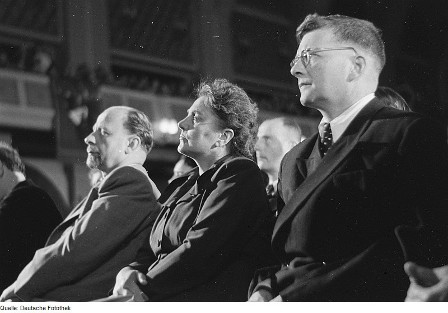The String Quartet no. 5 in B flat major, opus 92, was first performed in November 1953 following Stalin's death although it had been written one year earlier. The quartet introduces two elements that would become central to later quartets: the joining of all the movements to create a work without a pause, and a growing reference to personal rather than public matters. It was written after the 24 Preludes and Fugues for solo piano, opus 87, which Shostakovich had composed between October 1950 and March 1951. This work had its inspiration in the 1950 celebrations in Leipzig marking the bi-centenary of Bach's death. Shostakovich had attended these acting as judge at piano competitions 1. (The photograph below shows him seated at a concert in the festival next to Walter Ulbricht, the then leader of communist East Germany, and Ulbricht's wife Lotte.) Writing the 24 Preludes and Fugues had made Shostakovich proficient in counterpoint and this ease is evident in its increased use in future works, of which the Fifth Quartet is an example.
The movements are:
- Allegro non troppo, attacca
- Andante/Andantino, attacca
- Moderato – Allegretto
the work has a duration of about 32 minutes and like the Third Quartet is dedicated to the Beethoven Quartet.
The first movement, arguably one of the best in the cycle of quartets, begins with an invigorating rhythm similar to that which concluded the Fourth Quartet. The first four notes played on the viola at the start of this first movement are of special interest. These notes are a permutation2 of the D-S-C-H motif that occurs in a passage of breathtaking defiance at the conclusion of the final movement of his Tenth Symphony, a work whose opus number directly follows that of the Fifth Quartet. Permutation of the DSCH motif occur in each of the next three string quartets finally taking the correct form in the Eighth were it becomes a central pillar of the whole quartet. The use of the such a personal motif is reminiscent of Bach many of whose works contain the sequence of notes B-A-C-H 3.
Having made an oblique reference to himself with the four-note motif Shostakovich again alludes to personal matters by quoting bars from the finale of the Clarinet Trio in B flat 4 by Galina Ustvolskaya (1919-2006). She was a student of Shostakovich and a person “for whom he sheltered profound professional respect and tender personal feelings” but who later was to refuse his offer of marriage following the death of his first wife 5. Perhaps these personal themes explain the intense agitation expressed in thrilling counterpoint in the quartet's first movement. In the development section the various themes disappear and then reappear in different disguises and in a bouquet of fascinating combinations. Like old friends at a party they whirl around; converse with each other; start passionate, fevered discussions; flirt à deux, seduce; then resurface forever altered but affecting a snow-flake innocence. Only towards its end does this sense of agitation wane. The movement's coda is dominated by the Ustvolskaya quote played on the first violin and finally the original four-note motif can be heard on the viola motif whilst an uninterrupted high F on the first violin leads directly into the second movement.
Some movements in Shostakovich's cycle of string quartets reflect motifs from other quartets which seem in turn sense the mood of a third, just as images in a hall of mirrors reflect other images which themselves are seen in other reflections; each view is unique but each contains a fragment of another albeit at a different angle. In this B minor middle movement, the soul of the fifth quartet, we enter such a world. Quotes abound in this movement mostly from works that remained unpublished until the cultural thaw that followed Stalin's death in 1953. Shostakovich quotes the second and final movements of the Third Quartet and his First Violin Concerto6: both were works that were withheld from public performance7.
The contrast between this movement and the complexity and restlessness of the first could not be greater. But this is not the ghost music heard at the beginning and end of the last movement of the third quartet. In comparison that music is too animated. The music we now experience portrays the land where the ghosts dwell; it is a desolate world, observed with clinical dispassion; a still universe surveyed following the onslaught and after the rampage. The music assesses this landscape without bitterness or sadness but also without the sublime romance of the Second Quartet. Instead the comfortless, icy world is viewed with the detachment of an auditor. As the notes become scarcer, the spaces between them increase in pregnancy. Nature cannot support this vacuum, and suddenly less becomes more; emotional intensity swells into the silence.
The final movement is a sojourn into the tempo, élan and B flat major of the first movement. We sense the social promiscuity of our old friends who inhabited the party of the first movement, but their spark of life has dimmed. They are now ghosts who can not free themselves from, and ultimately must return to, the daunting world of the second movement. This austere quartet ends morendo over a glacial pedal note.
The fifth quartet is a difficult and complex piece which can endure, and certainly rewards, repeated listening. After completing the quartet Shostakovich admitted that he regarded it highly unlike his Fourth which he dismissed as being just entertaining. Nevertheless he felt that because 'musical circles' would react to it negatively, it could not be published8. So, like the Third and Fourth Quartets, the Fifth had to wait until Stalin died times before it could be performed. Fortunately it would not have to wait long.

